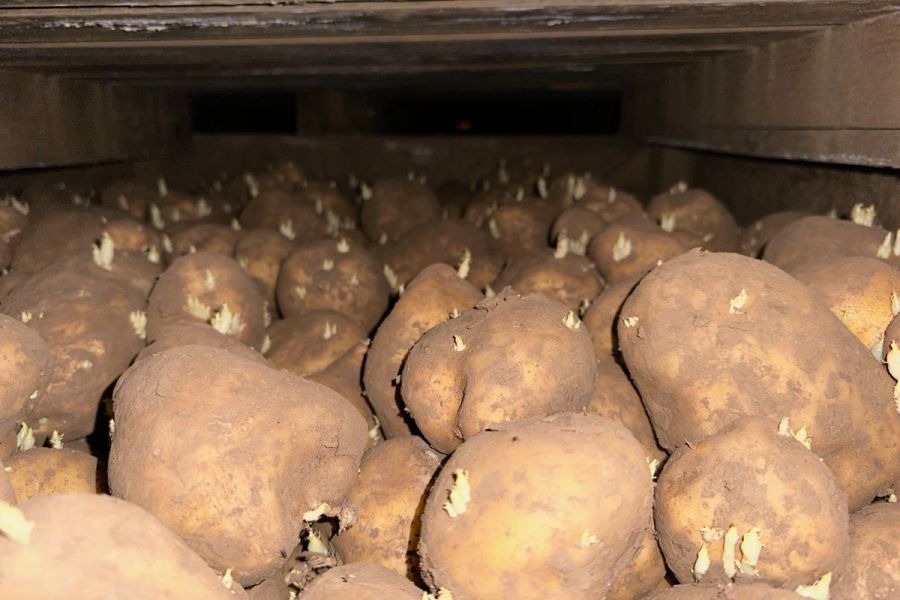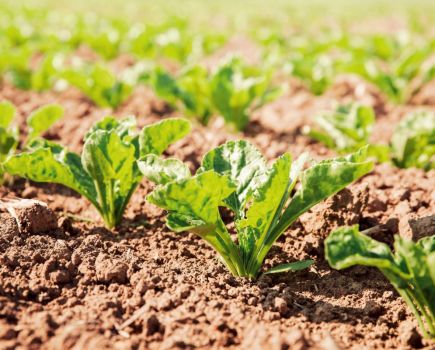Could ethylene finally be used safely in crisping and chip shop potato stores? CPM hears about advances in its use at a GB Potatoes SPot store event, run in conjunction with Potato Storage Insight and SDF Agriculture.
“We’re confident when growers use the PET system, they’ll see fry colours as good as they get with any other product.”
By Mike Abram
New technology that introduces micro-doses of ethylene into potato stores is being claimed to overcome the impact on crisp and chip fry colours – one of the main drawbacks of its use in those sectors – while still maintaining sprout control.
Ethylene is a naturally occurring plant growth regulator and, when maintained at suitable levels in stores, inhibits the elongation of sprouts. Since the loss of approval of chlorpropham (CIPC), it’s emerged as a relatively cheap alternative for packing and in some processing stores.
But concerns over darker fry colours have ruled out its application in potatoes destined for crisping or for use in fish and chip shops.
Such darker fry colours are caused when ethylene stimulates increased respiration rates in the potato, resulting in a sugar spike when starch is converted into reducing sugars. When the potatoes are fried, a chemical reaction occurs between those sugars and amino acids to produce a characteristic browning.
If the sugar level is too high in crisps and chips, that reaction goes too far beyond the desired pale golden colouring and consumer acceptance diminishes.
Research from the 1970s revealed there was an intrinsic link between tuber respiration and initial ethylene concentration, but it hasn’t been easy to manage because potatoes can detect ethylene at lower levels than the best currently available sensors can detect, explains Paul Coleman, director of technology for ethylene system supplier, Restrain.
“That’s why a lot of the time where fry colour hasn’t been great after the use of ethylene, it’s because of the way it’s been introduced,” he continues.
Both Restrain, which converts liquid ethanol into ethylene in a generator, and Biofresh, which pumps bottled ethylene gas into store through its ethylene management unit (EMU), use a ramping up system to introduce initial low doses of ethylene into the store before achieving the concentration required for sprout control.
The idea is, that helps the potato to acclimatise to the ethylene, reducing the impact on respiration rates and therefore reducing sugar production within the tuber. But the limit on being able to detect ethylene has knock-on constraints in being able to control the change in respiration rate in tubers.
“The challenge has been how do you introduce parts per billion of ethylene into stores, rather than parts per million,” says Paul.
But now, Restrain technical manager Adrian Briddon has created a way of delivering such super low doses into stores using the software and technology in the Restrain generator. “This software delivers micro doses of ethanol into the generator, which produces ethylene at just parts per billion level into the store,” explains Paul.
“We can’t detect it with sensors, but the potatoes detect it. Each day we build that up so the potatoes receive a slightly bigger dose but the respiration rate isn’t reacting, you achieve a much flatter ethylene respiration response rate.”
The process takes around a week and is now fully automated and the same for all varieties. After a week, Restrain’s conventional slow-start ramp-up begins when the ethylene concentration has reached the sensor’s lowest detectable level of around 0.1 ppm. That slowly increases to 10ppm – the level required for sprout suppression – during a period of 21 days.
But in comparison, the new Precision Ethylene Technology (PET) system starts at levels around a 100-fold lower, says Paul. “It’s a tiny amount of ethanol going in, but the clever thing is we can control it, which we weren’t able to do in the past.”
Trials on three crisping varieties, selected because they respond to ethylene by producing higher levels of sugars, show much better results than using ethylene without PET through PepsiCo fry test protocols.
“For example, the new variety VR808 can be fried without any concerns for colour using the PET system, and also SCH1010 which again now looks superb for fry colour.”
The results are equivalent to potatoes stores treated with 1,4Sight (1,4-dimethylnaphthalene), he adds.
These trials, however, have been conducted on crisping varieties stored in French fry processing stores, admits Paul. “These are 2OC colder than what the crisping industry uses, so we’d like to get some potatoes in crisping stores treated.”
Ethylene use in potatoes stored for French fry output is much more accepted, with McCain comfortable with its use. “The big difference between McCain French fries and chip shop chips is in a French fry factory they blanch the potato – wash it in hot water. That removes the sugar from the outside and helps to create the crispy texture. It’s then allowed to dry before frying and that process reduces fry colour risk.”
Despite the lack of testing in commercial crisping or chip shop potato stores, Paul believes the PET system will prove to be a big step change which will remove grower concerns surrounding fry colour in both the crisp and chip shop sectors.
“We’re confident when growers use the PET system, they’ll see fry colours in the chip shop and for crisps as good as they get with any other product.”
Industry experts agree the ramp-up procedure is crucial for best results from ethylene. Potato agronomist and storage expert Simon Faulkner from SDF Agriculture has been using a less sophisticated process of using a ‘sniff’ of ethylene in processing stores before turning the production off for four or five days and then starting a ramp up.
That’s worked well, he says. “It does appear a small application is beneficial to controlling fry colours – I’m getting enough dose in to acclimatise the potatoes before ramping up.”
He’s slightly more cautious about whether a micro-dosing approach will be enough to persuade crisping potato growers to change to ethylene, however. “I think growers remember some of the issues they had with ethylene when it was first introduced, which caused quite a lot of crop downgrading or loss.
“So they’re likely to be cautious. At some point, someone will ask about whether a company will underwrite its use, which opens another can of worms about how the store is managed, so it’s quite difficult.”
Potato Storage Insight’s Adrian Cunnington says micro-dosing is a good way to take ethylene forward. “The big issue we’ve had with ethylene is that its application was too clunky, especially before the ramp was brought in. Now they’re trying to refine it to get the ramp working better.
“The principle is right, because tubers react to too much ethylene – it’s like giving you a shot of adrenaline.”
Even so, he too thinks crisping and chip shop growers will remain reluctant to use ethylene. “The chip shop market has dabbled with ethylene and come unstuck so that’s not where you want to be. We want a little more confidence before giving people recommendations.”
He also believes there’s a desire for an earlier and better testing system for assessing ethylene risk in varieties. “Varieties are introduced into the market and then it’s thought whether to use ethylene. That’s the wrong way round – we should do the ethylene work earlier in the process so you can establish whether the variety works with ethylene or not,” suggests Adrian.
A potential alternative to managing the sugar spike in tubers with ethylene is to use recently approved 1-methylcyclopropene (1-MCP).
“It’s an ethylene blocker that’s supposed to inhibit the sugar spike,” explains Simon. “You apply it as 1 ppm. Allow the crop to settle down; cured and down to your holding temperature and then apply it as a single dose before you start the ethylene treatment. It costs around £6/t.”
A trial he conducted on behalf of GB Potatoes for the SPot storage event in Lincolnshire compared the in-store use of 1-MCP in combination with ethylene, with 1,4Sight across a range of processing varieties. A fry test was then conducted on each variety.
“There was a difference in fry colours between the two, but it was very subtle,” says Simon. “The question is whether growers want a marginal difference for a cost of £6/t,” he concludes.
This article was taken from the latest issue of CPM. Read the article in full here.
For more articles like this, subscribe here.
Sign up for Crop Production Magazine’s FREE e-newsletter here.




